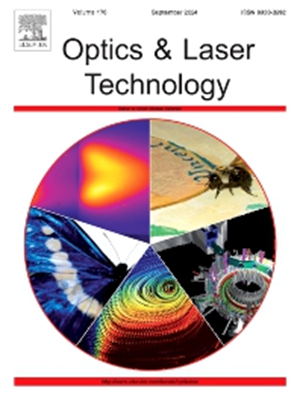An approach for improving the distorted structured light in holographic optical tweezers
IF 4.6
2区 物理与天体物理
Q1 OPTICS
引用次数: 0
Abstract
Optical tweezers have been widely used for optical manipulation of various particles. At present, there are different type of optical tweezers. Among them, holographic optical tweezers have attracted growing attention as a powerful tools for optical trapping, optical transportation and optical sorting in many fields, due to its excellent properties including great flexibility and high convenience. Experimentally, however, the structured light has been easily distorted, which would lead to serious degradation of optical manipulation performance. In this work, the distortion of structured light is theoretically analyzed. In the following, the distortion of structured light are numerically simulated and experimentally measured. It shows that the simulated results are in consistent with the experimental ones. Then, an approach for decreasing its optical distortion is proposed, and the results reveal that the distortion of structured light can be effectively corrected. Accordingly, our study provides a way for improving the distorted structured light, which is useful for optically manipulating various particles in optical tweezers.
求助全文
约1分钟内获得全文
求助全文
来源期刊
CiteScore
8.50
自引率
10.00%
发文量
1060
审稿时长
3.4 months
期刊介绍:
Optics & Laser Technology aims to provide a vehicle for the publication of a broad range of high quality research and review papers in those fields of scientific and engineering research appertaining to the development and application of the technology of optics and lasers. Papers describing original work in these areas are submitted to rigorous refereeing prior to acceptance for publication.
The scope of Optics & Laser Technology encompasses, but is not restricted to, the following areas:
•development in all types of lasers
•developments in optoelectronic devices and photonics
•developments in new photonics and optical concepts
•developments in conventional optics, optical instruments and components
•techniques of optical metrology, including interferometry and optical fibre sensors
•LIDAR and other non-contact optical measurement techniques, including optical methods in heat and fluid flow
•applications of lasers to materials processing, optical NDT display (including holography) and optical communication
•research and development in the field of laser safety including studies of hazards resulting from the applications of lasers (laser safety, hazards of laser fume)
•developments in optical computing and optical information processing
•developments in new optical materials
•developments in new optical characterization methods and techniques
•developments in quantum optics
•developments in light assisted micro and nanofabrication methods and techniques
•developments in nanophotonics and biophotonics
•developments in imaging processing and systems

 求助内容:
求助内容: 应助结果提醒方式:
应助结果提醒方式:


